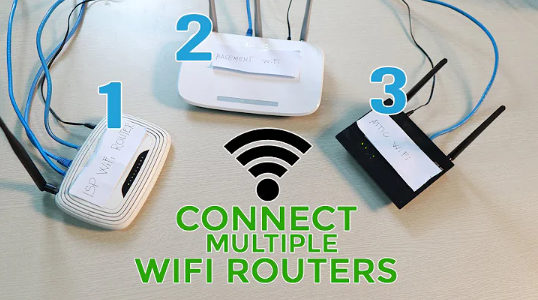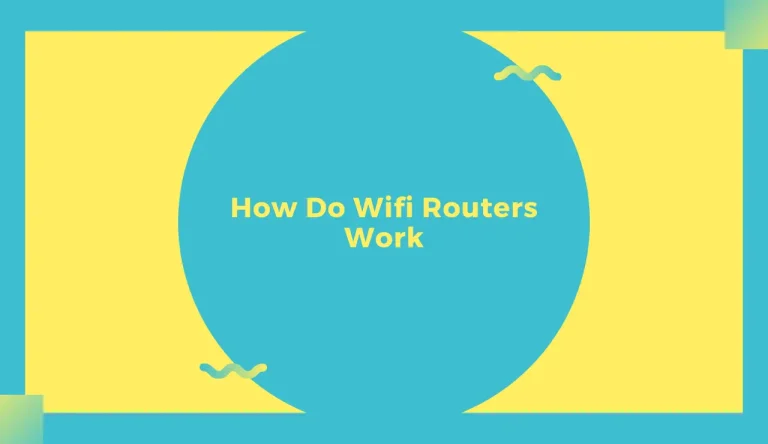How To Connect Two Wifi Routers Without Cable
Are you tired of experiencing weak WiFi signals in certain areas of your home or office? And want to know How To Connect Two Wifi Routers Without Cable Connecting two WiFi routers without the need for cables can be a great solution to extend your network coverage. By following a few simple steps, you can enjoy seamless connectivity throughout your entire space.
First, assess your existing WiFi coverage to identify the areas that need improvement. Then, choose the right router that meets your requirements and supports wireless bridging or repeating functionality.
Next, set up the primary router by connecting it to your modem and configuring its settings. Afterward, configure the secondary router to connect wirelessly with the primary one. Establishing a wireless connection between the two routers will ensure optimal performance and extended coverage.
Lastly, test and troubleshoot any connectivity issues that may arise during setup. With this hassle-free method, you can now enjoy uninterrupted internet access in every corner of your home or office. Say goodbye to dead zones and experience superior WiFi connectivity wherever you go!
Key Takeaways
- Weak WiFi signals can be solved by connecting two WiFi routers without cables.
- Assess existing WiFi coverage to identify areas that need improvement.
- Choose a router that supports wireless bridging or repeating functionality.
- Set up primary router by connecting it to modem and configuring settings.
Assess Your WiFi Coverage
Now that you’ve set up your primary WiFi router, it’s time to assess your WiFi coverage to ensure a seamless connection throughout your space.
Start by evaluating signal strength in different areas of your home or office. Use a WiFi analyzer app on your smartphone or laptop to check the signal quality and identify any dead spots where the connection is weak. This will help you determine if you need to extend the range with an additional router.
Next, optimize WiFi placement by positioning the primary router in a central location, away from obstructions such as walls or furniture that could interfere with the signal. Avoid placing it near other electronic devices that can cause interference, like cordless phones or microwave ovens.
By thoroughly assessing your WiFi coverage and optimizing its placement, you can ensure a strong and reliable connection throughout your space.
Now let’s move on to choosing the right router for extending your network without cables.
Choose the Right Router
When choosing the right router, you should research and compare different models to find the best fit for your needs.
Consider factors such as speed, range, and security features.
Additionally, take into account the specific needs of your space and devices, such as the number of users or the size of your home or office.

By carefully evaluating these aspects, you can ensure that you select a router that will provide reliable and efficient WiFi coverage in your environment.
Research and compare different router models
To find the perfect router for your needs, you’ll want to explore and compare various models. This will make your internet connection soar without any cables holding you back.
Start by comparing router features such as data transfer speeds, range, and security protocols. Look for routers with dual-band capabilities that support both 2.4GHz and 5GHz frequencies, as well as advanced features like beamforming or MU-MIMO technology.
Additionally, explore router compatibility with your existing devices and network infrastructure. Check if the router supports the latest wireless standards like Wi-Fi 6 or 802.11ac to ensure optimal performance. Consider factors like the number of Ethernet ports available for wired connections and the ability to set up a guest network for visitors.
By thoroughly researching and comparing different router models, you can choose one that fits your specific needs. Seamlessly transition into considering factors like space and device requirements in the next section.
Consider the specific needs of your space and devices
Take a moment to consider how your space and devices can benefit from the perfect router that’ll revolutionize your internet experience.
When choosing a router, it’s important to explore alternative solutions that fit your specific needs. Consider the size and layout of your space, as well as the number of devices that’ll be connected.
If you have a large home or office, you may need a router with longer range capabilities or the ability to create a mesh network for seamless coverage throughout the area.
Additionally, if you have multiple devices that require high bandwidth usage, such as gaming consoles or smart TVs, look for routers with advanced QoS features to prioritize traffic and ensure smooth performance.
It’s also crucial to consider potential limitations, such as interference from neighboring networks or obstacles like walls and furniture that could affect signal strength.
With these factors in mind, you can select a router that best suits your needs and set up the primary router seamlessly for optimal connectivity without any cables needed.
Set Up the Primary Router
First, you’ll need to position your primary router in a central location within your home, like the heart of a bustling city. This is crucial for optimal coverage and connectivity throughout your space. Ensure that the router is placed away from walls or obstructions that may interfere with the signal.
Connect one end of an Ethernet cable to the WAN port on the primary router and the other end to your modem. Power on both devices and wait for them to establish a connection.
Access the router’s settings by typing its IP address into a web browser on a connected device. Follow the instructions provided by your specific router model for initial setup, including configuring network name (SSID) and password.
Troubleshoot any connectivity issues by checking cable connections, restarting devices, or contacting customer support if needed.
Next, we will move on to setting up the secondary router without using a cable connection.
Set Up the Secondary Router
Now let’s dive into getting the second router up and running, effortlessly linking it to your existing network without any bothersome cables. Follow these steps to set up the secondary router:
- Access the router’s settings: Connect your computer to the secondary router using an Ethernet cable. Open a web browser and enter the default IP address of the router in the address bar.
- Configure basic settings: Set a unique SSID (network name) for the secondary router to differentiate it from your primary network. Also, make sure that both routers are operating on different channels to avoid interference.
- Enable bridge mode: To extend your Wi-Fi coverage with the secondary router, enable bridge mode or access point mode on its settings page.
Once you have completed setting up the secondary router, you may encounter some connection issues. Troubleshoot them by ensuring that both routers are within range of each other, updating firmware for compatibility, and disabling conflicting features like MAC filtering or firewall.
With the second router successfully configured, you can now move on to establishing a wireless connection between devices seamlessly.
Establish a Wireless Connection
To establish a wireless connection, simply ensure that your devices are in range of the secondary router and have the appropriate network settings configured.
Start by exploring wireless security options on your secondary router to protect your network from unauthorized access. Enable encryption protocols such as WPA2-PSK to safeguard your data. Additionally, change the default password for accessing the router’s settings to further enhance security.
Next, optimize signal strength by strategically placing the secondary router in a central location within its coverage area. Avoid obstructions like walls or large objects that can interfere with the signal. Adjust the antennas on the router for better reception and try different channels to minimize interference from neighboring networks.
With a properly established wireless connection, you can now proceed to test and troubleshoot any potential issues that may arise during operation.
Continue reading about how to test and troubleshoot in order to ensure a smooth functioning of your connected routers.
Test and Troubleshoot
One way to ensure a smooth functioning of your connected routers is by testing and troubleshooting any potential issues that may arise during operation.
To test the efficiency of your wireless connection, you can use various tools such as network analyzers or Wi-Fi signal strength apps. These tools will help you identify any weak spots in the coverage area or interference from other devices.
Additionally, you can try changing the channel on both routers to avoid interference from neighboring networks.
If you encounter any connectivity problems, there are several troubleshooting techniques you can employ. For example, power cycling both routers by turning them off and on again can often resolve minor issues.
Updating the firmware on your routers and ensuring they have compatible settings can also improve performance.
By thoroughly testing and troubleshooting your setup, you can enjoy extended wifi coverage without experiencing any significant disruptions or slowdowns in connectivity.
Enjoy Extended WiFi Coverage

If you want to experience a stronger and more reliable internet connection, it’s time to explore how to enjoy extended WiFi coverage.
By extending your WiFi network, you can make the most of seamless connectivity throughout your home or office.
Say goodbye to dead zones and slow internet speeds as you optimize your WiFi signal for maximum performance.
Experience a stronger and more reliable internet connection
By connecting two wifi routers without a cable, you can significantly enhance your internet connection, ensuring it remains strong and reliable at all times. Here are some key benefits of this setup:
- Boosting signal strength: With two routers strategically placed in different areas of your home or office, you can extend the coverage range and eliminate dead zones. This allows devices to connect seamlessly from anywhere within the premises.
- Improving network stability: By creating a mesh network using two routers, you create redundancy and minimize interference. This ensures a more stable and consistent internet connection even when multiple devices are connected simultaneously.
- Faster download and upload speeds: With improved signal strength and reduced interference, you can experience faster data transfer rates, allowing for quicker downloads and smoother streaming experiences.
- Enhanced security: Two routers enable separate networks with different passwords, enhancing overall network security.
With these advantages in mind, you can make the most of seamless connectivity throughout your home or office for an optimized online experience.
Make the most of seamless connectivity throughout your home or office
To continue experiencing a stronger and more reliable internet connection, it’s crucial to make the most of seamless connectivity throughout your home or office. One effective way to achieve this is by maximizing your WiFi signal and optimizing network performance.
By connecting two WiFi routers without cables, you can extend your wireless coverage and ensure a stable connection in every corner of your space.
To begin, select a primary router that’ll be connected directly to your modem. Then, choose a secondary router that’ll act as an access point. Connect the primary router to the modem using an Ethernet cable and configure its settings accordingly.
Next, connect the secondary router to the primary router wirelessly or via an Ethernet cable. Configure the secondary router’s settings as well.
By setting up these two routers in harmony, you can effectively expand your WiFi coverage area while maintaining optimum network performance. This method enables devices in different areas of your home or office to seamlessly connect to either router depending on which signal is stronger, ensuring uninterrupted browsing and smooth data transfer throughout your entire space.
Frequently Asked Questions
Conclusion
Congratulations! You’ve successfully connected two WiFi routers without the need for any cables. By carefully assessing your WiFi coverage and selecting the appropriate routers, you were able to set up both the primary and secondary router effectively.
Establishing a wireless connection between the two routers has extended your WiFi coverage, allowing you to enjoy a seamless internet experience throughout your entire space.
Remember to test and troubleshoot if any issues arise, ensuring optimal performance at all times. Enjoy your extended WiFi coverage!






